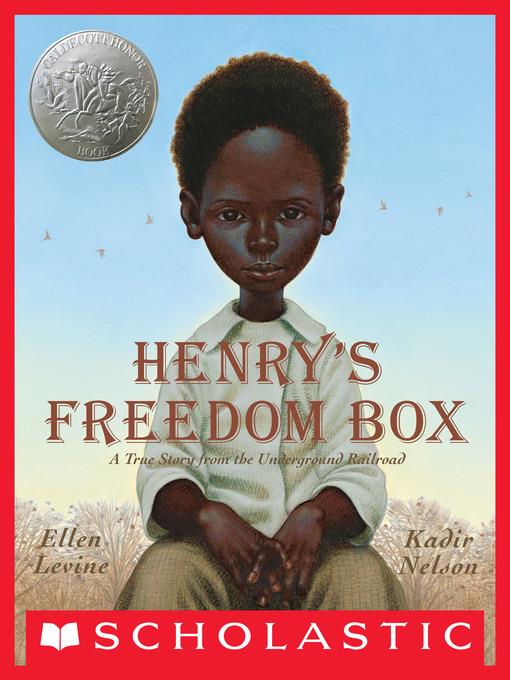
Henry's Freedom Box
فرمت کتاب
ebook
تاریخ انتشار
2016
Lexile Score
490
Reading Level
0-2
ATOS
3
Interest Level
K-3(LG)
نویسنده
Kadir Nelsonناشر
Scholastic Inc.شابک
9781338082654
کتاب های مرتبط
- اطلاعات
- نقد و بررسی
- دیدگاه کاربران
نقد و بررسی

cutipup200511 - I like the book but not the part when he lies so he can get to freedom because he did not like working for a white man who would boss him around so he Put something on his hand that burned a hole right through it so when he was bandaged up by his master and shipped himself to Philadelphia to get away from slavery and he finally had a real birthday.

January 1, 2007
Levine (Freedom's Children
) recounts the true story of Henry Brown, a slave who mailed himself to freedom. Thanks to Nelson's (Ellington Was Not a Street
) penetrating portraits, readers will feel as if they can experience Henry's thoughts and feelings as he matures through unthinkable adversity. As a boy, separated from his mother, he goes to work in his new master's tobacco factory and eventually meets and marries another slave, with whom he has three children. In a heartwrenching scene depicted in a dramatically shaded pencil, watercolor and oil illustration, Henry watches as his family—suddenly sold in the slave market—disappears down the road. Henry then enlists the help of an abolitionist doctor and mails himself in a wooden crate "to a place where there are no slaves!" He travels by horse-drawn cart, steamboat and train before his box is delivered to the Philadelphia address of the doctor's friends on March 30, 1849. Alongside Henry's anguished thoughts en route, Nelson's clever cutaway images reveal the man in his cramped quarters (at times upside-down). A concluding note provides answers to questions that readers may wish had been integrated into the story line, such as where did Henry begin his journey? (Richmond, Va.); how long did it take? (27 hours). Readers never learn about Henry's life as a free man—or, perhaps unavoidably, whether he was ever reunited with his family. Still, these powerful illustrations will make readers feel as if they have gained insight into a resourceful man and his extraordinary story. Ages 4-8.

March 1, 2007
Gr 2-5-Inspired by an actual 1830s lithograph, this beautifully crafted picture book briefly relates the story of Henry "Box" Brown's daring escape from slavery. Torn from his mother as a child, and then forcibly separated from his wife and children as an adult, a heartsick and desperate Brown conspired with abolitionists and successfully traveled north to Philadelphia in a packing crate. His journey took just over one full day, during which he was often sideways or upside down in a wooden crate large enough to hold him, but small enough not to betray its contents. The story ends with a reimagining of the lithograph that inspired it, in which Henry Brown emerges from his unhappy confinementin every sense of the wordand smiles upon his arrival in a comfortable Pennsylvania parlor. Particularly considering the broad scope of Levine's otherwise well-written story, some of the ancillary "facts" related in her text are unnecessarily dubious; reports vary, for instance, as to whether the man who sealed Henry into the crate was a doctor or a cobbler. And, while the text places Henry's arrival on March 30, other sources claim March 24 or 25. Nelson's illustrations, always powerful and nuanced, depict the evolution of a self-possessed child into a determined and fearless young man. While some of the specifics are unfortunately questionable, this book solidly conveys the generalities of Henry Brown's story."Catherine Threadgill, Charleston County Public Library, SC"
Copyright 2007 School Library Journal, LLC Used with permission.

Starred review from February 1, 2007
Although the cover shows a young boy staring intently at the reader, this book is really about Henry Brown as an adult and a staggering decision he made to achieve freedom. Henry, born a slave, hears from his mother that leaves blowing in the wind "are torn from the trees like slave children are torn from their families." When his master grows ill, Henry hopes that he will be freed; instead, he is given to his master's son, and his life becomes worse. Eventually, Henry marries and has children; then his family is sold. With nothing left to lose, he asks a white abolitionist to pack him in a crate so he can be mailed to freedom. The journey is fraught with danger as he travels by train and then steamboat, but 27 hours later, he reaches Philadelphia. A brief author's note confirms the details of the story, but it's the dramatic artwork that brings the events emphatically to life. According to the flap copy, an antique lithograph of Brown inspired Nelson's paintings, which use crosshatched pencil lines layered with watercolors and oil paints. The technique adds a certain look of age to the art and also gives the pictures the heft they need to visualize Brown's life. Transcending technique is the humanity Nelson imbues in his characters, especially Brown and his mother--her dream of freedom deferred, his amazingly achieved.(Reprinted with permission of Booklist, copyright 2007, American Library Association.)

























دیدگاه کاربران